


Malachite

SOME GEOLOGY & GEMS
(A TRIP TO THE USA 2009)
In 2009 I was fortunate to spend some 8 weeks travelling through many of the national parks in the
western half of the USA. As part of that trip I visited a number of museums which had excellent
mineral/gemstone collections as well as 'rock shops' and national parks that demonstrate vividly many
aspects of the science of geology. The following photos are a very brief summary of some of the many
wonders to be seen in the western half of the USA.

L: Crater Lake N.P. in Oregon. Formed from the shattered
remains of an eruption some 7700 yrs ago, the lake is some 592m
deep and 9.6km across at it's widest point.
R: The pinnacles, beside Crater Lake, are a colourful collection of
30m tall spires that are being eroded from the canyon walls. The
spires are 'fossil fumeroles', each marking a spot where volcanic
gas rose up through hot ash deposits, cementing the ash into solid
rock
L: The 'John Day Fossil Beds', (Oregon) Painted Hills Unit. The
hills are the result of the erosion & weathering of volcanic ash
under a variety of climatic regimes. The area has yielded many
excellent fossils
R: The 'John Day Fossil Beds', Sheep rock unit has the visitor
information centre with fossil exhibits. This fossil skull has been
distorted by pressures underground, making it difficult to identify.
L: A staff member at The 'John Day Fossil Beds' undertaking work
on fossils recovered locally.
R: A fossilised skull at the 'John Day Fossil Beds', Sheep rock unit.
L: Butte, Montana, has been a major copper mining area, with a
large open cut pit replacing underground mining in 1955. The
mineral museum has a nice display of minerals and gemstones.
R: Butte museum, Butte, Montana. Sulphur specimen. The
museum is located on the Montana Tech Campus. It has over
1300 minerals on exhibit, including a 27.5 oz gold nugget.
L: Butte museum, Butte, Montana. Flourite specimen.
R: A geyser in Yellowstone N.P. The last major volcanic eruptions
occurred around 640,000 yrs ago. The central caldera, some
75km across, is still underlaid by magma which still powers the
parks geysers, hot springs and mudpots.
L: Old Faithful Geyser, erupts at intervals which have varied from
40 to 126 minutes. The time of the next eruptions can generally be
predicted to within about 10 minutes at present.
R: The Badlands N.P. in South Dakota show the effects of
sedimentation and erosion over some 75 million years. It is a
source of many fossils.
L: Mt Rushmore, South Dakota. This is a rather impressive
example of stone 'carving' compared to what most lapidaries do!
Constructed between 1927 & 1941, using dynamite and
jackhammers plus 400 workers; each face is 18.3m high. The
presidents (L to R) are George Washington, Thomas
Jefferson,Theodore Roosevelt , Abraham Lincoln
R: There are plenty of rock shops in the mining states such as
Montana, South Dakota, Colorado & Arizona. Lapidary shops are
less common.
L: Some of the petrified wood on display. Note the 'wood' from
arizona (red, white & yellow). I saw magnificent polished sections
of tree trunks (1m in diameter) of this material at Bryce canyon in
Utah
R: There are many nice agate specimens in the rock shops in the
USA plus fossils & minerals on display.
L: The shop had a wide range of rocks, fossils & minerals on
display.
R: You can purchase more than just 'rocks' at this shop.
L: A place well worth visiting is the 'Mammoth site' at Hot Springs
in South Dakota, just south of Mt Rushmore. A large number of
male mammoth fossils are preserved in situ in what was a
sinkhole. The site dates to approx. 25,000 years ago.
R: The many mammoths that died in what was a sinkhole, are
slowly being excavated by paid staff and volunteers. The site
dates to approx. 25,000 years ago.
The Denver Museum of Natural History
L: This specimen was dug up in the last few years by a fossicker. It measures approx. 1m high! The Denver Museum of Natural History is well worth a visit by lapidaries and mineral collectors. It has a fantastic collection of minerals & gems. To the immediate left are some crystals of aquamarine and tourmaline. L: This specimen is covered by gem quality beryl crystals, up to 10mm wide. The full specimen is shown above (the photo does not do it justice). One of many high quality specimens at the Denver Museum of Natural History, Denver, Colorado R: A display of agates at the Denver museum of natural history. L: Some of the lovely Rhodochrosite specimens at the museum. R: A display of gold leaf specimens at Denver Museum, Colarado. Part of a larger collection of gold specimens. L: The 'rhodo pocket' from the famous 'Sweet Home Mine', covered with gemmy rhodochrosite crystals. Approx. 3m long by 2m wide. R:A closer view of the 'rhodo' pocket from the Alma King mine. L: The 'Alma King' specimen measures some 1m high and is covered with fine quartz, calcite and flourite crystals as well as the magnificent 'Alma King crystal'. Well worth a visit. R: The famous 'Alma King' rhodochrosite specimen. The main crystal is approx. 6" across. The Colorado School of Mines Geology Museum, in Golden, Colorado, has been in it's impressive new two storey building since 2003. The current director, Bruce Geller & his staff are very welcoming and informative. Well worth visiting! R: A lovely specimen of Elbaite on Albite (200mm wide). One of many high quality specimens at the Colorado School of Mines Geology Museum L: Flourite on Sphalerite, Colorado School of Mines Geology Museum R: Shorl on Albite v. Cleavelandite L: A view of a small part of the interior of the Colorado School of Mines Geology Museum. R: Apophyllite with Stilbite from India, Colorado School of Mines Geology Museum L: The fossil displays at the museum are set up in a clear, informative way. Grouping the fossils into their relative geological eras provides a good sense of the progression of fossils through those eras. R: One of many displays of gems at the Colorado School of Mines Geology Museum. The museum has very informative labelling of it's displays. L: Part of another display of high quality gems at the Colorado School of Mines Geology Museum, the peridot in the centre is a flawless 130.47ct gem. R: A Rhodochrosite specimen to die for! L: The 'Colorado Fire Necklace', featuring a magnificent collection of faceted Rhodochrosites, is one of the attractions at the Colorado School of Mines Geology Museum. R: A lovely Aragonite specimen at the Colorado School of Mines Geology Museum. L: Monument Valley, Arizona. R: Bryce Canyon, a classical example of differential erosion, is one of the most beautiful national parks in the U.S.A. and a 'must see' for any visitors. Water erodes the rock both mechanically (when fast moving water, carrying sediments, abrade the rock) and chemically (as slow moving water enters the rocks and dissolves the 'natural cements' holding the grains of rock together). A FANTASTIC EXPERIENCE -ATTENDING THE 2007 TUCSON GEM SHOW I was fortunate to travel to the U.S.A. for the first time this year and I made a point of visiting the Tucson Gem show. I am glad I did the trip and would recommend it to other gem collectors/hobbyists if they get the opportunity. The show is big, really big! It consists of some 38 locations/'shows' around Tucson, of which 13 were wholesale only.There are hundred and hundreds of dealers covering all aspects of lapidary work/mineral collecting/jewelry manufacturing etc. Many of the shows are there to supply the professional jewelry trade but there are also many applicable to the amateur lapidary enthusiast/mineral or fossil collector. A large range of equipment manufacturers were present covering all areas of lapidary work (faceting equipment, laps, saws, cabbing equipment, tumblers, sphere makers etc). I found the the 'Tucson Electric Park Gem & Mineral Show' had the greatest concentration of equipment suppliers this year. Mineral specimens were available at many of the shows, but the most spectacular/high quality specimens I saw were at the 'Tucson Westward Look Mineral Show' and at the 'Tucson Gem and Mineral Show' (in the convention centre during the last 4 days of 'Tucson'). Faceting and cabbing rough was available at several of the shows, including the JG & M show in Palo Verde (a suburb of Tucson) and at the 'Globe-X/Days Inn' show in the centre of town. Photos: by row, L to R 1st row: The Globex show at Days Inn, Tucson, Arizona, U.S.A., 2007. The show filled the motel plus a large number of marquees. ; Some of the traders at the Globex show. There were hundreds of traders at 'Globex', as there were at several of the 38 sites around Tucson. 2nd row: Some of the cathedrals and caves at the Globex show 3rd row: L Some of the cathedrals and caves at the Globex show; R The 'Gem Mall' had a large range of beads, manufactured jewelry and other items for sale 4th row: L to R An impressive display of minerals including Golden beryl crystals and rubellite/// The size and quality of the crystals on display was most impressive, as this kunzite crystal shows/// A magnificent azurite specimen. 5th row: L to R Goran (A geologist from Canada/Serbia), holding a magnificent rubellite specimen at the Westward Look Mineral Show/// A close-up view of the rubellite specimen./// A large and rather magnificent aquamarine crystal valued in excess of $80,000 (U.S.D.) 6th row: L to R An impressive malachite specimen./// A lovely aquamarine specimen./// This large quartz crystal was covered with a coating of multi coloured calcite, making a most attractive specimen. The Tucson Show Guide, which is provided free at the shows, gives a detailed listing of where all the dealers/traders are located, and should be studied carefully to ensure you make good use of your time at the shows. Regular visitors to the shows are also a great source of knowledge. During the 2 weeks duration of the 'shows', a free shuttle bus service enables visitors to travel around the various locations. Based on my limited experience this year, I would say that you do not really need a car when attending the Tucson shows. There were plenty of Australians at the show this year, with Australian gems/minerals being a special feature at this years show. I attended several lectures by Australian miners/cutters/dealers and was impressed by the way they represented Australia. Well done! One of the advantages of attending the show was meeting a lot of friendly and knowledgeable fellow lapidary enthusiasts and mineral collectors. A second positive was the quality of gems and minerals on display. They were better than anything I have seen in the past and I now appreciate what people mean when they talk of really top quality gems and mineral specimens. View the slide show to the left for more photos. THE GIA AT CARLSBAD As well as the Tucson show I visited the Gemmological Institute of America's Campus at 5345 Armada Drive, Carslbad in California (it is almost next door to 'Legoland'). If you are in California it is well worth a visit, the GIA run tours of the facility and you will see a great selection of crystals, cut gems and the like. It is necessary to phone ahead to book in if you wish to visit the campus. Photos: L The entrance to the GIA campus at Carlsbad in California. R The musical instruments for an orchestra produced from carved gem material and gold. SMITHSONIAN MUSUEM, WASHINGTON DC, USA, 2011 TRIP During 2011, as part of a trip in the eastern half of the USA, I was fortunate to visit the Smithsonian Museum of Natural History, in Washington D.C. I had read that it had a fantastic mineral & gem collection, and I was not disappointed. Well worth a visit if you have the opportunity. Some of the collection is shown below, though the photos do not do the collection justice. However I am sure you will enjoy the mineral specimens and gemstones shown, I went back to the museum on 3 consecutive days to try to absorb the beauty of the collection!
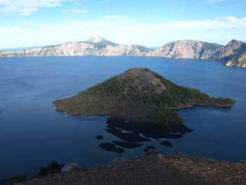
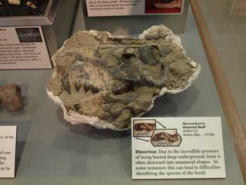
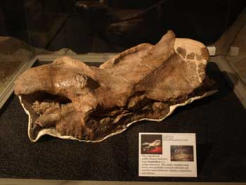
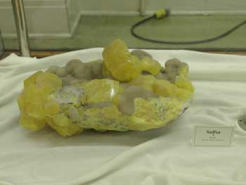
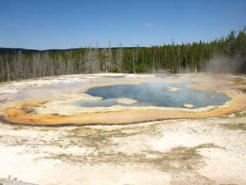
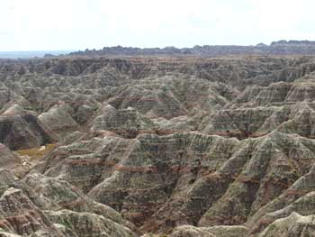
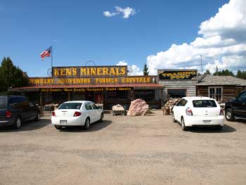
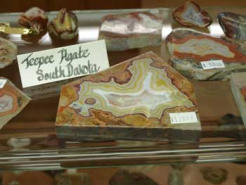
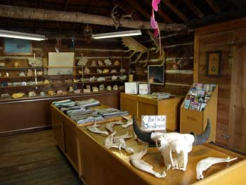
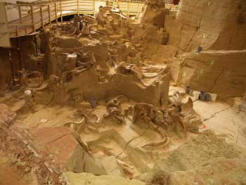
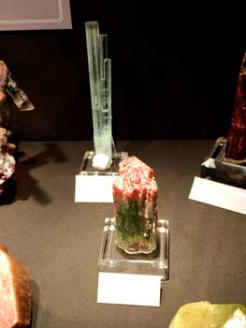
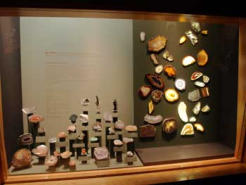
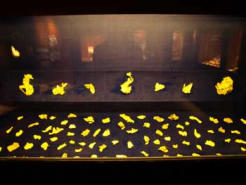
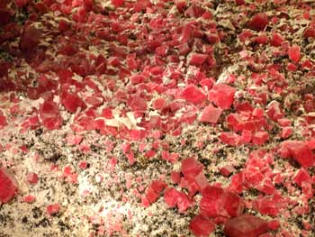
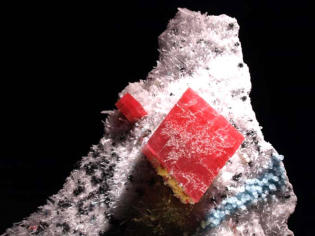
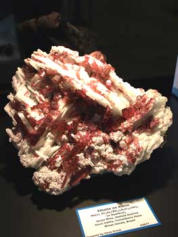
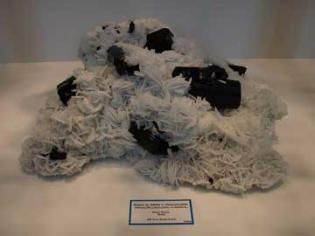
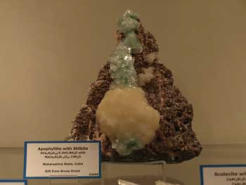
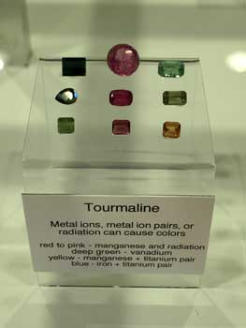
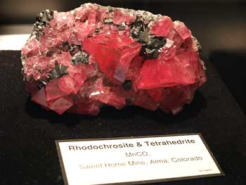
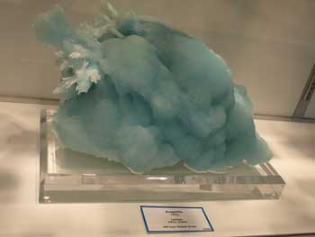
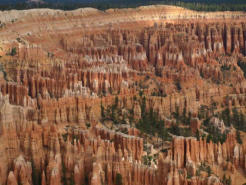
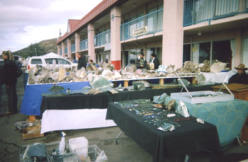
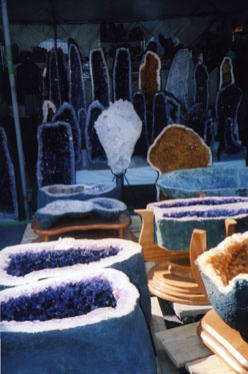
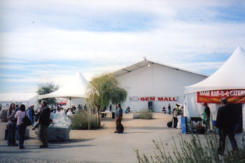
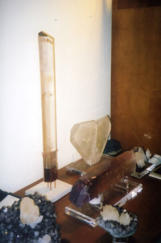
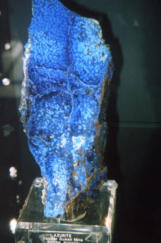
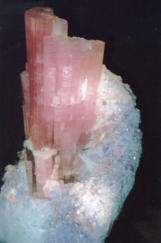
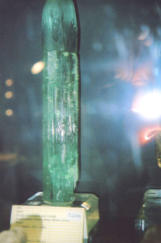
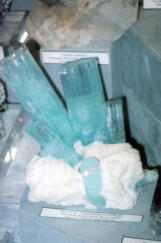
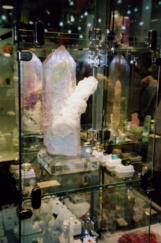
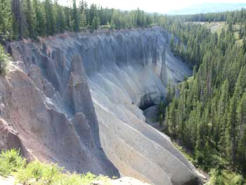
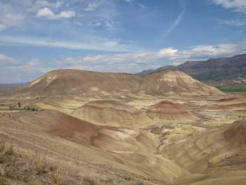
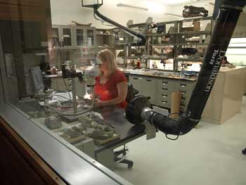
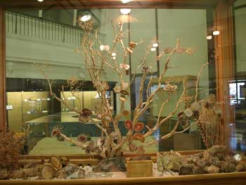
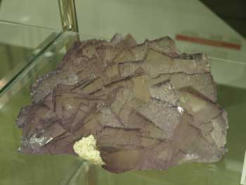
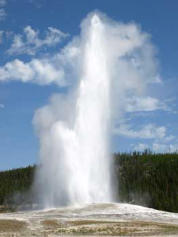
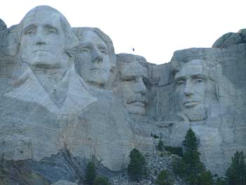
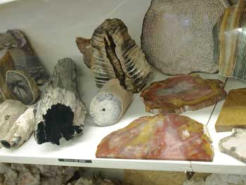
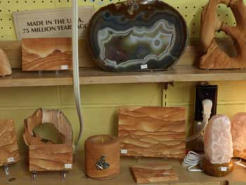
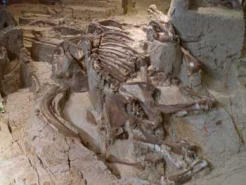
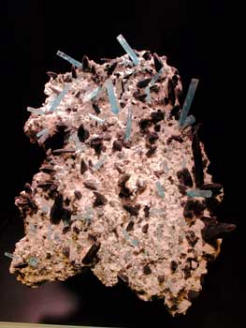
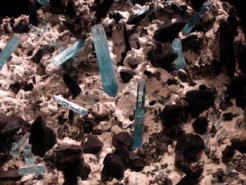
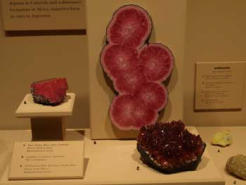
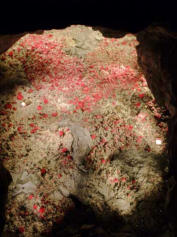
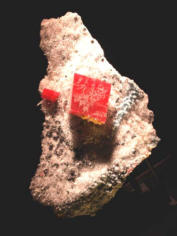
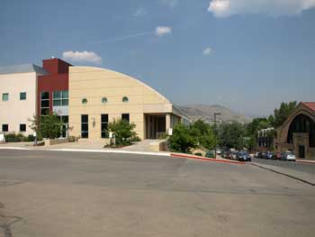
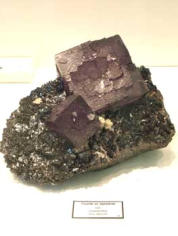
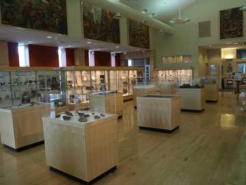
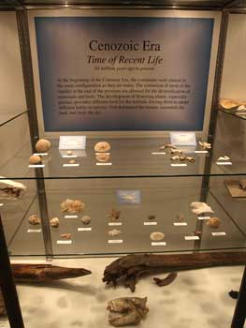
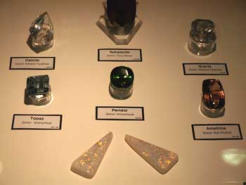
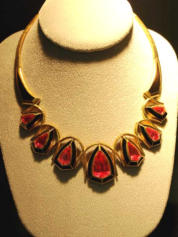
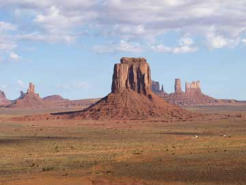
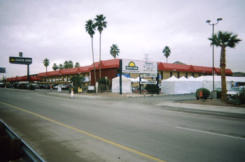
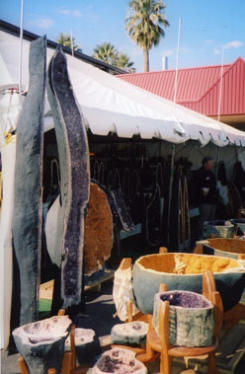
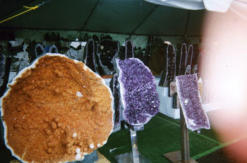
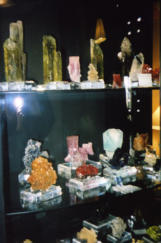
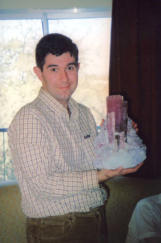
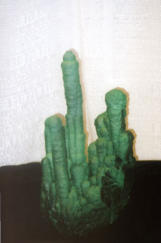
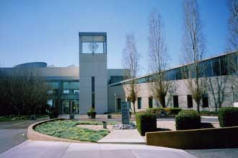
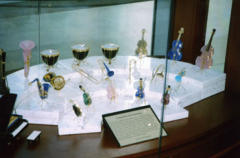
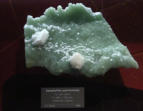
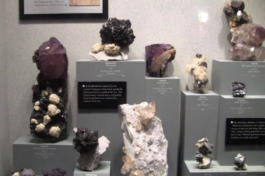
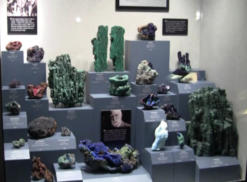
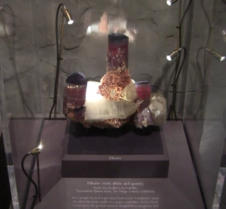
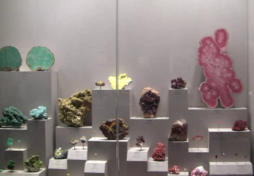
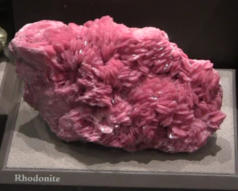
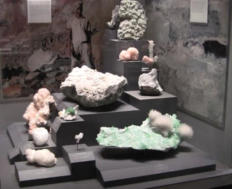
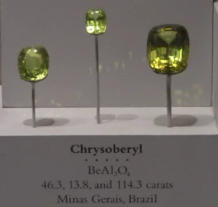
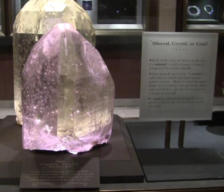
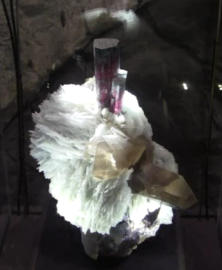
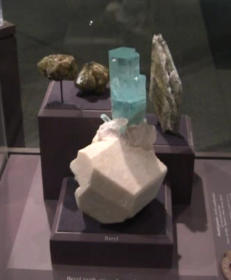
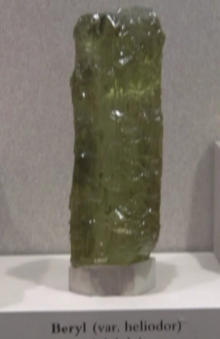
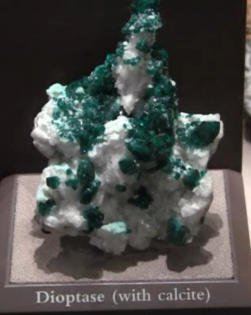
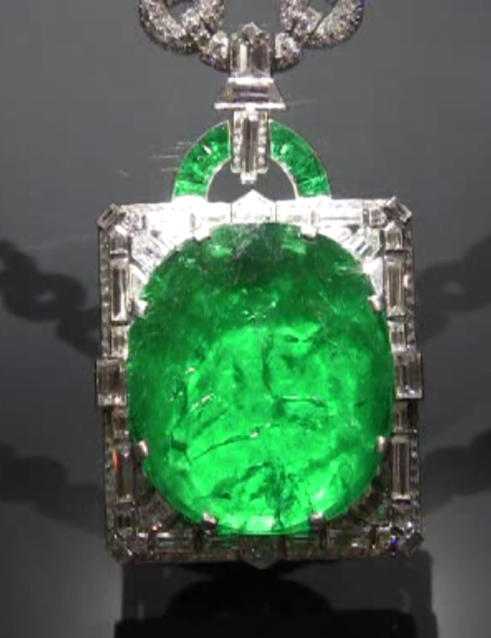
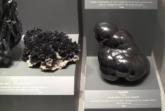
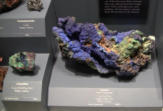
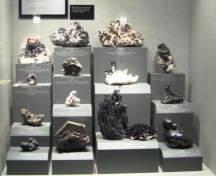
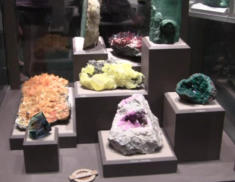
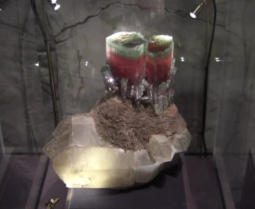
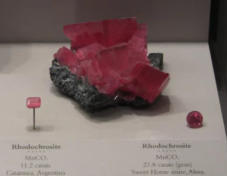
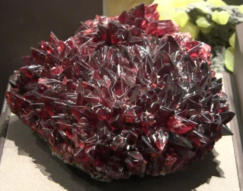
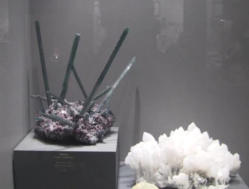
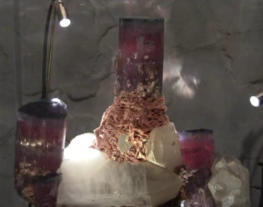
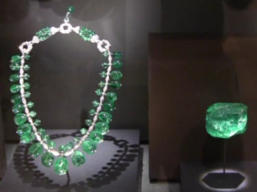
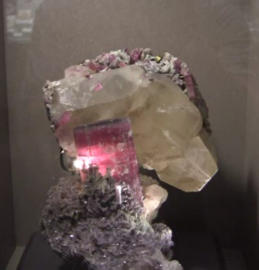
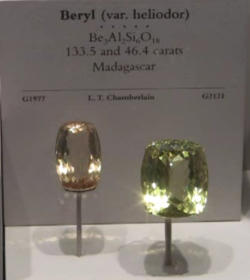
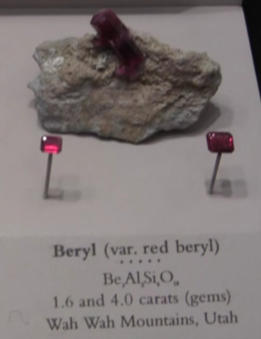
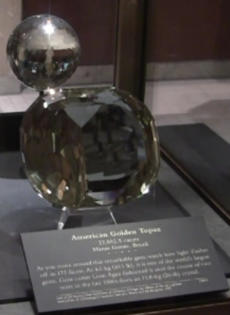
L to R: A magnificent Apophyllite and Prehnite
specimen; Some botroyoidal
Hematite; A specimen of Azurite with Malachite.
L: A typical display in the museum, well labelled and
lit.
R: A fine collection of metal/mineral specimens,
showing a variety of forms.
L: A collection of copper based minerals from the well
known location of Bisbee, Arizona, U.S.A.
R: A display highlighting the aesthetic appeal of
mineral specimens.
Magnificent ‘blue cap’ tourmaline specimens in their
display cases.
L: An attractive display including Rhodochrosite and
Varascite specimens.
R: Rhodochrosite!
L: A spectacular specimen of Rhodonite.
R: More Rhodochrosite
L: A display of Indian zeolites from the Poona district.
R: Some impressive Elabaite (tourmaline) crystals.
L: The largest faceted Chrysoberyl gemstones I have
seen!
R: Three magnificent ‘blue cap’ tourmaline specimens
in their display case.
L: A 51 lb pink Topaz crystal, quite spectacular (gem
quality).
R: Emerald jewellery
Magnificent ‘blue cap’ tourmaline specimens
L: Beryl (aquamarine) on Albite
R: Two lovely Beryl gemstones.
L: A Beryl (Helidor) crystal, approx. 200mm high.
R: Faceted beryl gemstones.
L: Dioptase crystals on Calcite
R: Faceted topaz gem.
A magnificent emerald.
Photos below: Two of the very large and spectacular
fossils on display
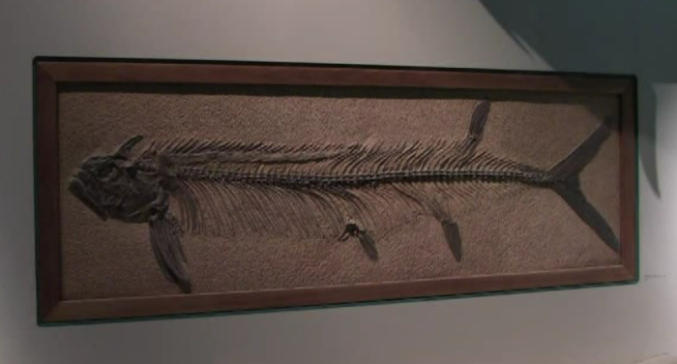
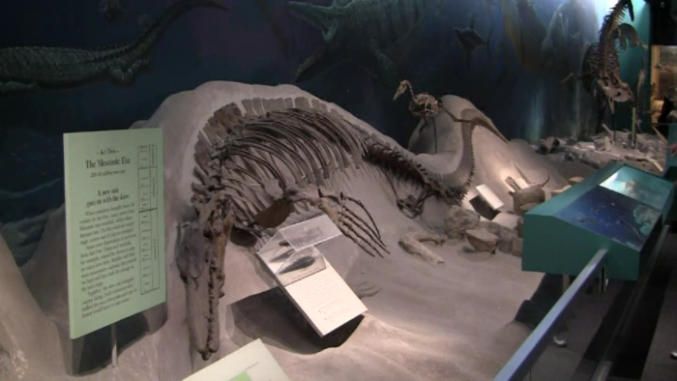
The video below is a MPG4 video and should not be watched
unless you have internet download speeds of 3 or more Mb/s
and unlimited download allowances. It shows some parts of
the Smithsonian museum’s gems & minerals displays.


- index
- contact-us
- club activities 2021 -
- Club activities 2021 --a
- Club activities 2021 --b
- club activities 2019_20
- club activities 2017_18
- club activities 2016
- club activities 2015_2014
- club activities 2013_2012_2011
- club activities 2010_2009_2008
- club activities 2007_2006_2005_2004
- club shows 2004_2016
- club shows 2018 _
- office bearers and life members
- club history
- links
- fossicking in south west victoria
- places you might like to visit
- europe 2014
- usa_canada_gems_geology
- Canada_hawaii_gems_geology
- gem_mineral collections
- some australian gems
- Gem articles
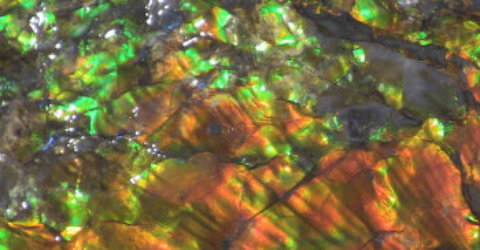


Elbaite crystals

SOME GEOLOGY &
GEMS
(A TRIP TO THE USA 2009)
In 2009 I was fortunate to spend some 8 weeks travelling through
many of the national parks in the western half of the USA. As part of
that trip I visited a number of museums which had excellent
mineral/gemstone collections as well as 'rock shops' and national
parks that demonstrate vividly many aspects of the science of
geology. The following photos are a very brief summary of some of the
many wonders to be seen in the western half of the USA.
Crater Lake N.P. in Oregon.
Formed from the shattered
remains of an eruption some 7700
yrs ago, the lake is some 592m
deep and 9.6km across at it's
widest point.
The pinnacles, beside Crater
Lake, are a colourful collection of
30m tall spires that are being
eroded from the canyon walls. The
spires are 'fossil fumeroles', each
marking a spot where volcanic gas
rose up through hot ash deposits,
cementing the ash into solid rock
A geyser in Yellowstone N.P. The
last major volcanic eruptions
occurred around 640,000 yrs ago.
The central caldera, some 75km
across, is still underlaid by magma
which still powers the parks
geysers, hot springs and mudpots.
Old Faithful Geyser, erupts at
intervals which have varied from
40 to 126 minutes. The time of the
next eruptions can generally be
predicted to within about 10
minutes at present.
Mt Rushmore, South Dakota. This
is a rather impressive example of
stone 'carving' compared to what
most lapidaries do! Constructed
between 1927 & 1941, using
dynamite and jackhammers plus
400 workers; each face is 18.3m
high. The presidents (L to R) are
George Washington, Thomas
Jefferson,Theodore Roosevelt ,
Abraham Lincoln
There are plenty of rock shops in
the mining states such as
Montana, South Dakota, Colorado
& Arizona. Lapidary shops are
less common.
There are many nice agate
specimens in the rock shops in the
USA plus fossils & minerals on
display.
A place well worth visiting is the
'Mammoth site' at Hot Springs in
South Dakota, just south of Mt
Rushmore. A large number of
male mammoth fossils are
preserved in situ in what was a
sinkhole. The site dates to approx.
25,000 years ago.
The Denver Museum of
Natural History
This specimen was dug up in the last few years by a fossicker. It measures approx. 1m high! The Denver Museum of Natural History is well worth a visit by lapidaries and mineral collectors. It has a fantastic collection of minerals & gems. To the left are some crystals of aquamarine and tourmaline. A display of agates at the Denver museum of natural history. A display of gold leaf specimens at Denver Museum, Colarado. Part of a larger collection of gold specimens. The 'Alma King' specimen measures some 1m high and is covered with fine quartz, calcite and flourite crystals as well as the magnificent 'Alma King crystal'. Well worth a visit. The famous 'Alma King' rhodochrosite specimen. The main crystal is approx. 6" across. The Colorado School of Mines Geology Museum, in Golden, Colorado, has been in it's impressive new two storey building since 2003. The current director, Bruce Geller & his staff are very welcoming and informative. Well worth visiting! Shorl on Albite v. Cleavelandite A view of a small part of the interior of the Colorado School of Mines Geology Museum. One of many displays of gems at the Colorado School of Mines Geology Museum. The museum has very informative labelling of it's displays. A Rhodochrosite specimen to die for! The 'Colorado Fire Necklace', featuring a magnificent collection of faceted Rhodochrosites, is one of the attractions at the Colorado School of Mines Geology Museum. Bryce Canyon, a classical example of differential erosion, is one of the most beautiful national parks in the U.S.A. and a 'must see' for any visitors. Water erodes the rock both mechanically (when fast moving water, carrying sediments, abrade the rock) and chemically (as slow moving water enters the rocks and dissolves the 'natural cements' holding the grains of rock together). A FANTASTIC EXPERIENCE -ATTENDING THE 2007 TUCSON GEM SHOW I was fortunate to travel to the U.S.A., visiting the Tucson Gem show. I recommend it to other gem collectors/hobbyists. The show consists of 38 locations or ‘'shows' around Tucson, of which 13 were wholesale only.There are hundreds of dealers covering all aspects of lapidary work/mineral collecting/jewelry manufacturing etc. A large range of equipment manufacturers were present. I found the the 'Tucson Electric Park Gem & Mineral Show' had the greatest number of equipment suppliers this year. Mineral specimens were at many of the shows, but the most spectacular/high quality specimens were at the 'Tucson Westward Look Mineral Show' and at the 'Tucson Gem and Mineral Show'. Photos: Top downwards. 1 The Globex show at Days Inn, Tucson, Arizona, U.S.A., 2007. The show filled the motel plus a large number of marquees. 2 Some of the cathedrals and caves at the Globex show 3 The 'Gem Mall' had a large range of beads, manufactured jewelry and other items for sale 4 An impressive display of minerals including Golden beryl crystals and rubellite/// The size and quality of the crystals on display was most impressive, as this kunzite crystal shows/// A magnificent azurite specimen. 5 Goran (A geologist from Canada/Serbia), holding a magnificent rubellite specimen at the Westward Look Mineral Show. 6 This large quartz crystal was covered with a coating of multi coloured calcite, making a most attractive specimen. During the 2 weeks duration of the 'shows', a free shuttle bus service enables visitors to travel around the various locations. Based on my limited experience this year, I would say that you do not really need a car when attending the Tucson shows. One of the advantages of attending the show was seeing the quality of gems and minerals on display. They were better than anything I have seen before. View the slide show below for more photos. THE GIA AT CARLSBAD I also visited the Gemmological Institute of America's Campus at Carslbad in California (it is almost next door to 'Legoland'). The GIA run tours of the facility and you will see a great selection of crystals, cut gems and the like. It is necessary to book ahead. Photos: Top: The entrance to the GIA campus at Carlsbad in California. Bottom: The musical instruments for an orchestra produced from carved gem material and gold.
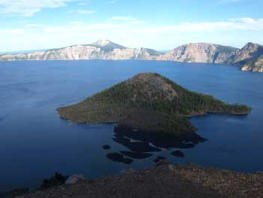
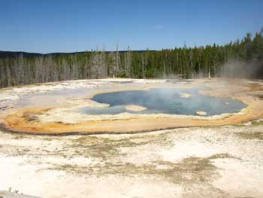
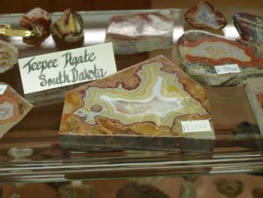
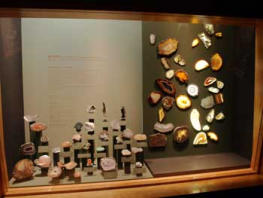
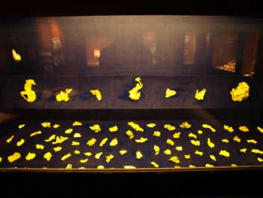
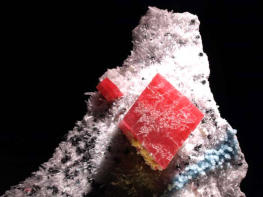
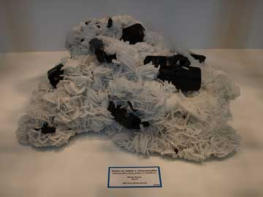
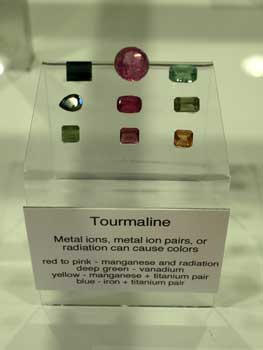
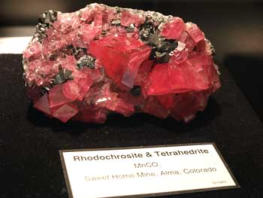
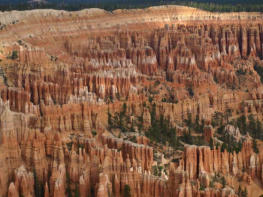
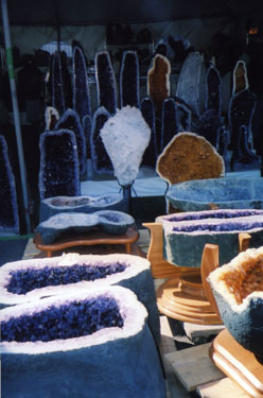
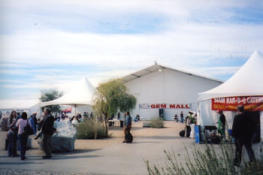
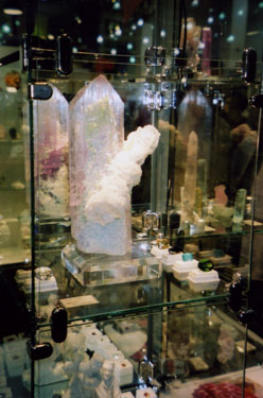
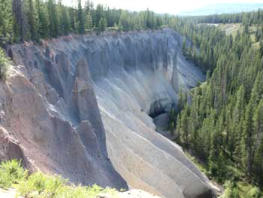
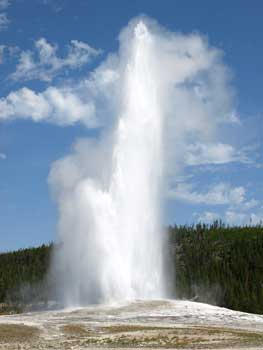
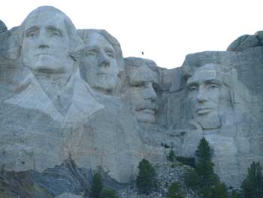
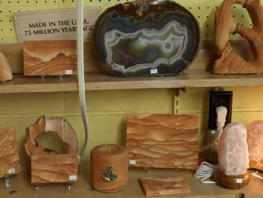
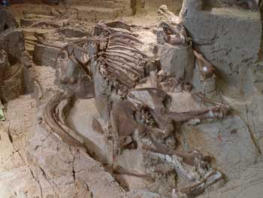
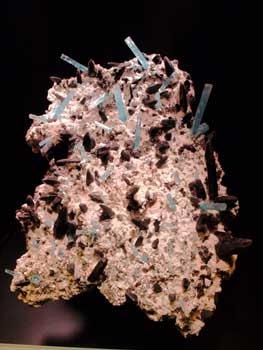
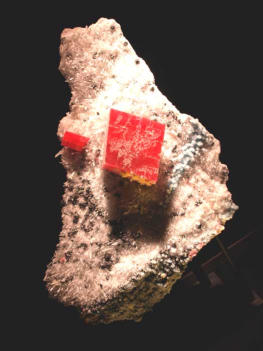
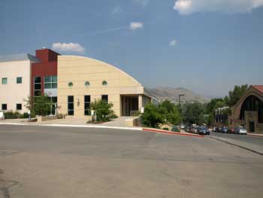
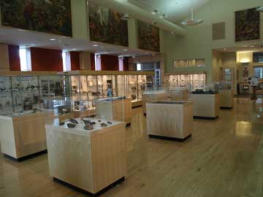
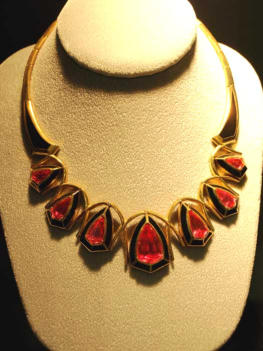
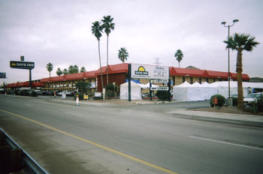
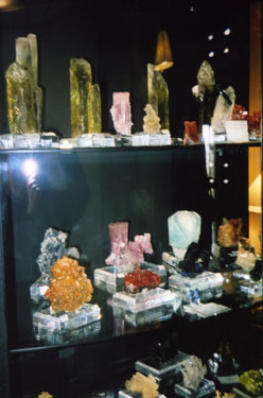
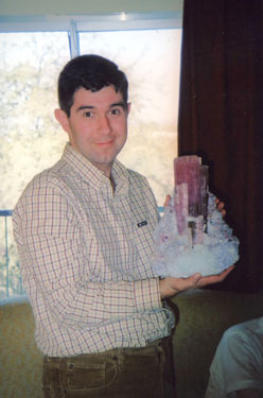
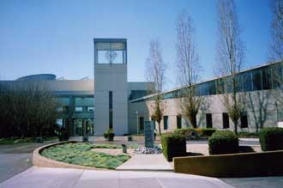
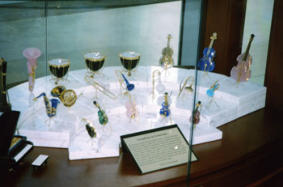
SMITHSONIAN MUSUEM, WASHINGTON DC,
USA, 2011 TRIP
During 2011, as part of a trip in the eastern half of the USA, I was fortunate to visit the
Smithsonian Museum of Natural History, in Washington D.C. I had read that it had a
fantastic mineral & gem collection, and I was not disappointed. Well worth a visit if you
have the opportunity. Some of the collection is shown below, though the photos do not
do the collection justice. However I am sure you will enjoy the mineral specimens and
gemstones shown, I went back to the museum on 3 consecutive days to try to absorb
the beauty of the collection!
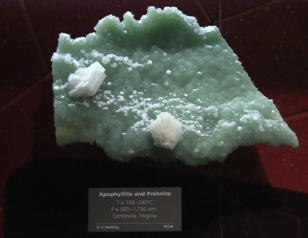
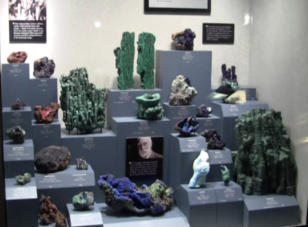
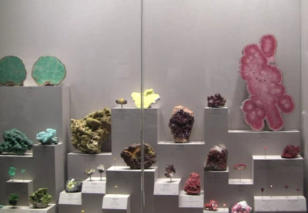
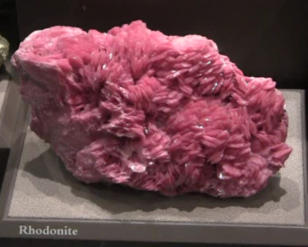
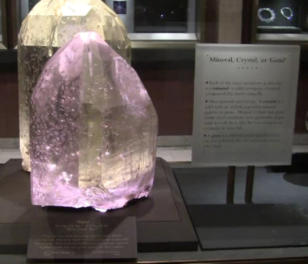
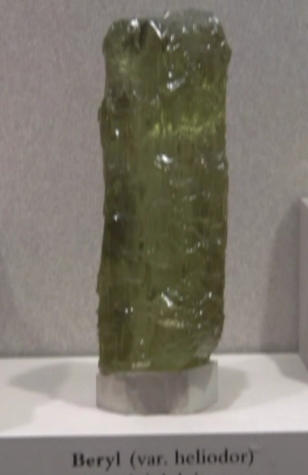
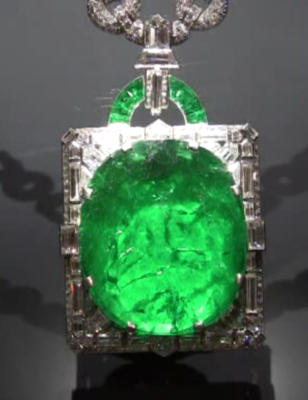
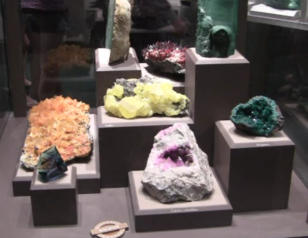
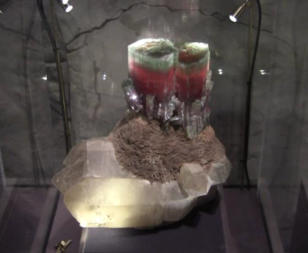
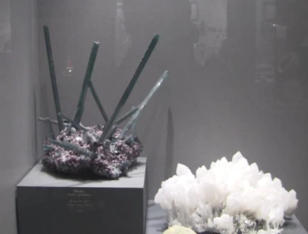
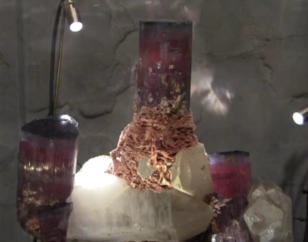
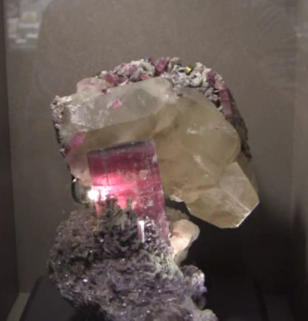
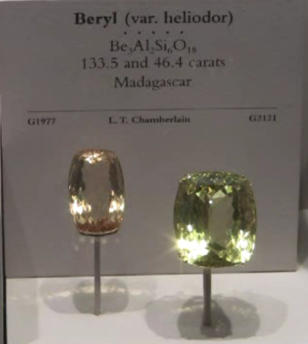
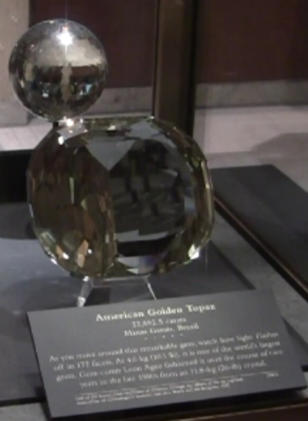
A magnificent
Apophyllite and
Prehnite specimen;
A collection of copper
based minerals from
the well known
location of Bisbee,
Arizona, U.S.A.
A display highlighting
the aesthetic appeal
of mineral specimens.
Magnificent ‘blue cap’
tourmaline specimens
in their display cases.
An attractive display
including
Rhodochrosite and
Varascite specimens.
A spectacular
specimen of
Rhodonite.
Some impressive
Elabaite (tourmaline)
crystals.
Three magnificent
‘blue cap’ tourmaline
specimens in their
display case.
A 51 lb pink Topaz
crystal, quite
spectacular (gem
quality).
Magnificent ‘blue cap’
tourmaline specimens
Two lovely Beryl
gemstones.
A Beryl (Helidor)
crystal, approx.
200mm high.
A massive faceted
topaz gem.
A magnificent
emerald.
Photos below: Two of
the very large and
spectacular fossils on
display


The video below is a MPG4 video
and should not be watched unless
you have internet download
speeds of 3 or more Mb/s and
unlimited download allowances. It
shows some parts of the
Smithsonian museum’s gems &
minerals displays.


- index
- contact-us
- club activities 2021 -
- Club activities 2021 --a
- Club activities 2021 --b
- club activities 2019_20
- club activities 2017_18
- club activities 2016
- club activities 2015_2014
- club activities 2013_2012_2011
- club activities 2010_2009_2008
- club activities 2007_2006_2005_2004
- club shows 2004_2016
- club shows 2018 _
- office bearers and life members
- club history
- links
- fossicking in south west victoria
- places you might like to visit
- europe 2014
- usa_canada_gems_geology
- Canada_hawaii_gems_geology
- gem_mineral collections
- some australian gems
- Gem articles











